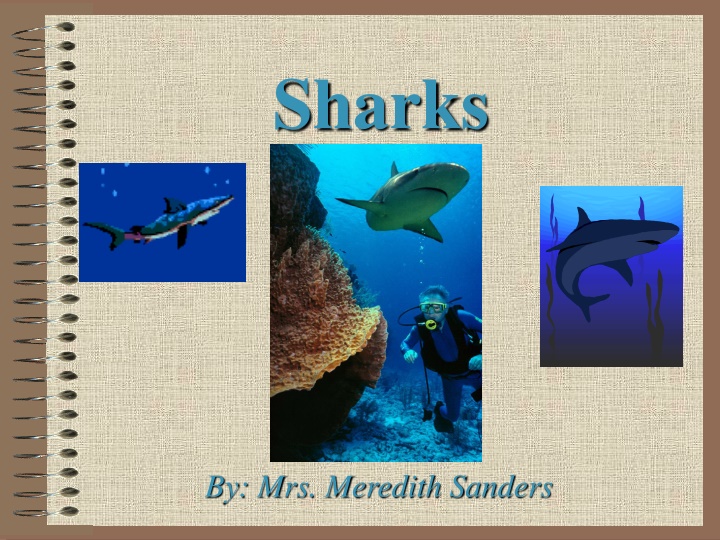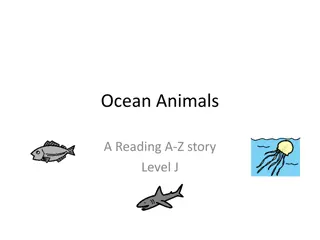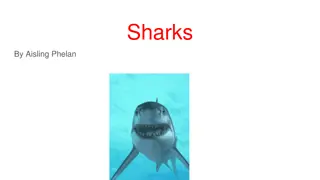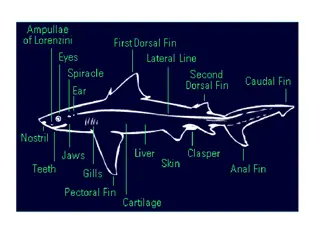Fascinating Facts About Great White Sharks
Great white sharks are incredible creatures with unique abilities and characteristics. From their teeth replacement process to their impressive speed in the water, these sharks are truly fascinating. They are also known for their size, with pregnant females carrying multiple babies. Despite their reputation as man-eaters, some scientists believe great whites may be more curious than predatory towards humans.
Download Presentation

Please find below an Image/Link to download the presentation.
The content on the website is provided AS IS for your information and personal use only. It may not be sold, licensed, or shared on other websites without obtaining consent from the author.If you encounter any issues during the download, it is possible that the publisher has removed the file from their server.
You are allowed to download the files provided on this website for personal or commercial use, subject to the condition that they are used lawfully. All files are the property of their respective owners.
The content on the website is provided AS IS for your information and personal use only. It may not be sold, licensed, or shared on other websites without obtaining consent from the author.
E N D
Presentation Transcript
Sharks By: Mrs. Meredith Sanders
Great White Shark Information TEETH TO SPARE If great white sharks had tooth fairies, they d be rich! A great white loses and replaces thousands of its teeth during its lifetime. Its upper jaw is lined with 26 front-row teeth; its lower jaw has 24. Behind these razor-sharp points are many rows of replacement teeth. The spares move to the front whenever the shark loses a tooth. At any one time about one-third of a shark s teeth are in the replacement stage. HEADS UP Great whites are the only sharks that can hold their heads up out of the water. This ability allows them to look for potential prey at the surface. Great white sharks usually attack from underneath, surprising their unwary prey
BOX OFFICE BULLY & SPEEDY SWIMMERS Great white sharks are superstars. Before the Star Wars series, the 1975 movie Jawswas Hollywood s biggest moneymaker. Jaws, about a great white on the prowl, cost $8 million to film but made $260 million in the U.S. Not bad for a fish story! Great white sharks can sprint through the water at speeds of 43 miles an hour (69 kilometers an hour). That s about 8.5 times as fast as the top Olympic swimmer. Scientists on the California coast tracked one shark as it swam all the way to Hawaii 2,400 miles (3,862 kilometers) in only 40 days!
SPEEDY SWIMMERS & HOT ON THE TRAIL Great white sharks can sprint through the water at speeds of 43 miles an hour (69 kilometers an hour). That s about 8.5 times as fast as the top Olympic swimmer. Scientists on the California coast tracked one shark as it swam all the way to Hawaii 2,400 miles (3,862 kilometers) in only 40 days! Unlike most fish, great white sharks bodies are warmer than their surroundings. The sharks bodies can be as much as 27.3 F (15.17 C) warmer than the water the fish swim in. A higher temperature helps the great white shark swim faster and digest its food more efficiently. Very useful for an animal that s always on the go!
BIG MAMA & SNEAK ATTACK A pregnant female great white shark can carry as many as 14 babies in her belly. At birth, a 5-foot-long (1.52-meter), 60- pound (22-kilogram) pup looks and acts like a miniature adult. Great whites average between 10 and 15 feet (3 and 4.6 meters) long. Females tend to be bigger than males. The longest confirmed great white shark measured 19.5 feet (5.9 meters). Male or female, they re the world s largest meat-eating fish. A great white shark isn t all white. A pale belly and dark charcoal-gray back help the shark avoid detection by prey. Viewed from above, the shark s dark-colored back blends with the murky seafloor. From below, the shark s belly matches the light-colored surface. Sneaky!
NOT ON THE REGULAR MENU Man-eaters? Maybe not. Some scientists believe that great white sharks are better described as man-biters. In more than half of all known great white attacks on swimmers, sharks have taken only a single bite before swimming away. Scientists speculate that perhaps people just don t taste as good as seals or sea lions!
Confirmed Unprovoked Shark Attacks Florida 520 Hawaii 104 California 89 South Carolina 52 North Carolina 30 Texas 32 Oregon 18 Mississippi 1 Total in USA from 1670-2005: 902
What is a Shark? Sharks are amazing fish that have been around since long before the dinosaurs existed. They live in waters all over the world, in every ocean, and even in some rivers and lakes. Unlike bony fish, sharks have no bones; their skeleton is made of cartilage, which is a tough, fibrous substance, not nearly as hard as bone. Sharks also have no swim bladder (unlike bony fish).
The Biggest Shark The biggest shark is the whale shark (Rhincodon or Rhiniodon typus), which can be up to 50 feet (15 m) long. It is a filter feeder and sieves enormous amounts of plankton to eat through its gills as it swims. It is also the biggest fish. The second biggest fish and shark is the basking shark (Cetorhinus maximus) which is about 40 feet (12.3 m) long and is another filter feeder. The biggest meat-eating sharks are the Greenland shark and the Great white shark (Carcharodon carcharias) which grow to be up to 21 feet (6.4 m) long. Great whites up to 37 feet (11.3 m) long have been reported, but not verified.
SCARIEST SHARK EVER (NOW EXTINCT) The largest shark known was the Megalodon (Carcharodon or Carcharocles megalodon); it is now extinct. It was an ancient, meat-eating shark that lived between 25 million and 1.6 million years ago. It was up to 40 feet (12 m) long and its teeth were each the size of a person's hand!
Smallest Sharks Dwarf Lanternfish (Etmopterus perryi), which is about 7 1/2 to 8 inches (19 - 20 cm) long for fully-grown females and 6 to 7 inches (16 - 17.5 cm) long for adult males Spined pygmy shark (Squaliolus laticaudus), which is about 8 inches (21 cm) long for fully-grown females and 7 inches (18 cm) long for males Pygmy ribbontail catshark (Eridacnis radcliffei) , which is about 6 to 7 inches (15 - 16 cm) long for fully-grown females and 7 to 7 1/2 inches (18 - 19 cm) long for males.
MOST DANGEROUS The oceanic white-tipped sharks are the most fearless predators. Jacques-Yves Cousteau says that it is: "the only species of shark that is never frightened by the approach of a diver, and they are the most dangerous of all sharks."
FASTEST The fastest swimming sharks are the mako sharks and blue sharks, which can even leap out of the water. They are also among the fastest fish. Estimates of their speed varies; some say that they can swim at about 60 miles per hour (97 kph), while more conservative estimates are about 22 mph (35 kph). There hasn't been enough observation of their speeds to have a definitive answer.
BIGGEST MOUTH The whale shark has the biggest mouth among sharks.
LONGEST TAIL The thresher sharks have the longest tail among sharks; the upper lobe of their tails are about the same length as their bodies.
STRONGEST SHARK BITE The strongest shark bite belongs to the dusky shark (Carcharhinus obscurus); its jaws have been measured to exert 132 pounds (60 kg) of force per tooth (James Snodgrass and Perry Gilbert, 1965).
MOST COMMON SHARK The piked dogfish shark (Squalus acanthias) is very abundant, especially in the North Atlantic Ocean. It is a small shark, about 63 inches (1.6 m) long.
LARGEST EGGS The whale shark was long thought to be oviparous (an egg 14 inches (36 cm) long was found in the Gulf of Mexico in 1953; this would be the largest egg in the world). Recently, pregnant females have been found containing hundreds of pups. Whale sharks are viviparous, giving birth to live young. Newborns are over 2 feet (60 cm) long.
DEEPEST DIVER The Portuguese shark dives down over 9,000 feet (2750 m). This is over 1.5 miles.
LONGEST MIGRATION The Blue shark had been known to migrate from 1,200-1,700 miles (2000-3000 km) in a seasonal journey from New York state in the USA to Brazil.
LARGEST LITTER One Blue shark was found with 135 pups in her uterus.
This powerpoint was kindly donated to www.worldofteaching.com http://www.worldofteaching.com is home to over a thousand powerpoints submitted by teachers. This is a completely free site and requires no registration. Please visit and I hope it will help in your teaching.























